Veganism is one of the fastest-growing movements in the world, and vegan food is rapidly gaining popularity. This rise in interest is driven by the health benefits, positive environmental impact, and ethical considerations associated with a plant-based lifestyle. As more people embrace veganism, understanding vegan food options has become essential.
Whether you’re a seasoned vegan, a curious newcomer, or just looking to add more plant-based choices to your diet, this comprehensive blog will provide extensive vegan food lists and insights into various aspects of veganism.
Vegan Food List for Beginners
So let’s first understand what is veganism (if you are familiar with it, you can directly go to the vegan food list section)
What is Veganism?
Veganism is a lifestyle that aims to avoid all forms of exploitation (as far as possible) and cruelty to animals. This approach extends beyond diet to include clothing, cosmetics, and other areas of life. Vegans do not consume or use animal products, including meat, poultry, fish, eggs, dairy, honey, leather, wool, and fur. They also oppose practices like animal rides, circuses, and zoos.
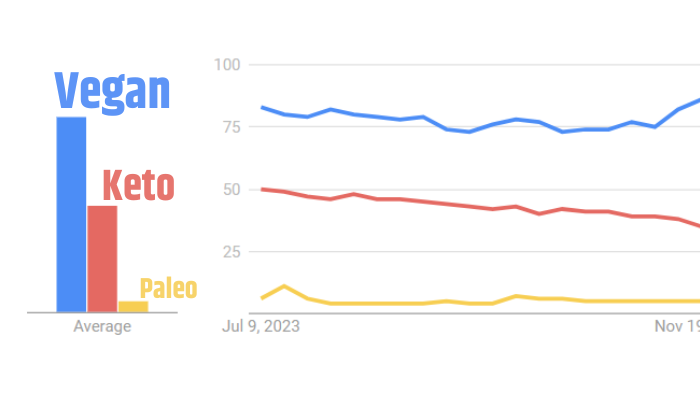
By adopting veganism, individuals help prevent the killing and exploitation of animals, protect the environment, and often experience health benefits.
Note: Veganism doesn’t take away the fun from life; it offers cruelty-free alternatives. You can enjoy mock meat instead of meat, plant-based milk instead of dairy, and much more!
What is Vegan Food?
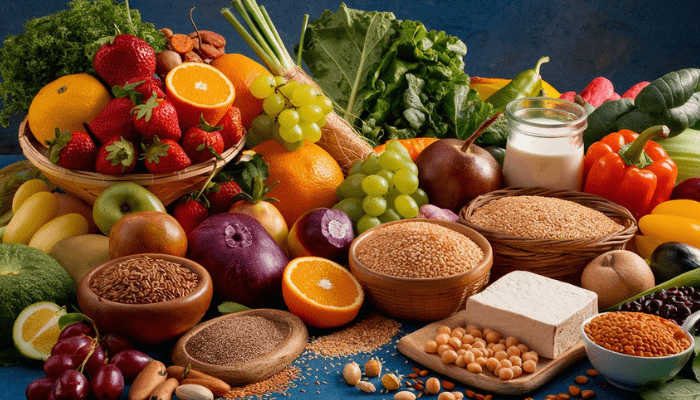
Vegan food is completely free of animal ingredients and by-products, making it a cruelty-free choice. This means no meat, poultry, fish, eggs, dairy products, honey, gelatin, or any other substances derived from animals are used.
Instead, vegan food is entirely plant-based, including fruits, vegetables, grains, legumes, nuts, and seeds. These foods can provide all the essential nutrients, vitamins, and minerals your body needs.
However, vegans need to take supplements for vitamin B12 and vitamin D, as these nutrients are not naturally found in plant-based foods. Other than these, all necessary nutrients are available from plant sources. Some fortified foods may also contain added vitamin B12 and vitamin D.
Fact: Each vegan saves the lives of as many as 365 animals annually.
Vegan vs. Vegetarian vs. Non-Veg
| Diet Type | Consumes | Avoids | Additional Considerations |
| Vegan | Fruits, vegetables, grains, nuts, seeds, legumes, tofu, tempeh, plant-based milk, etc. | Meat, poultry, fish, eggs, dairy, honey, animal by-products (leather, wool, fur), animal exploitation (circuses, zoos) | Emphasizes ethical and environmental concerns. |
| Vegetarian | Fruits, vegetables, grains, nuts, seeds, legumes, tofu, tempeh, plant-based milk, dairy products (lacto-vegetarian), eggs (ovo-vegetarian), both dairy and eggs (lacto-ovo vegetarian) | Meat, poultry, fish | Varies depending on type of vegetarianism. Often focuses on health and ethical concerns. |
| Non-Vegetarian | Meat, poultry, fish, eggs, dairy, fruits, vegetables, grains, legumes | Typically none | Most inclusive diet, providing a wide range of nutrients. Export to Sheets |
Foods That Aren’t Vegan
Understanding which foods aren’t vegan can be straightforward. Foods are non-vegan if they come from animal-derived ingredients or contain animal products. Here’s a list of common non-vegan foods:
- Meat: Includes beef, pork, chicken, lamb, and other animals.
- Poultry: Such as chicken, turkey, duck, and more.
- Fish and Seafood: Like salmon, tuna, shrimp, and other sea creatures.
- Dairy Products: Including milk, cheese, yogurt, butter, and ice cream.
- Eggs: From chickens, ducks, quails, and other birds.
- Honey: Produced by bees.
- Gelatin: Made from animal collagen, often found in gummy candies and desserts.
- Lactose: A type of sugar found in milk and dairy products.
- Casein: A protein found in milk and used in many dairy products.
- Whey: A byproduct of cheese production, often found in protein powders and processed foods.
- Certain Candies: Many candies contain gelatin, milk powder, or shellac (an insect-derived resin).
- Marshmallows: Typically contain gelatin unless labeled as vegan.
- Certain Breads: Some bread recipes include eggs, milk, or honey.
- Refined Sugar: Some refined sugars are processed using bone char.
- Certain Wines and Beers: Some alcoholic beverages use isinglass (fish bladder) for clarification.
- Mayonnaise: Traditional mayo contains eggs.
- Some Dressings and Sauces: Certain dressings and sauces include dairy, eggs, or anchovies (like Caesar dressing).
Fact: Producing just 1 pound of beef requires 2,500 gallons of water.
These items are not part of a vegan diet, which focuses on plant-based foods and excludes all animal products.
Vegan Food List
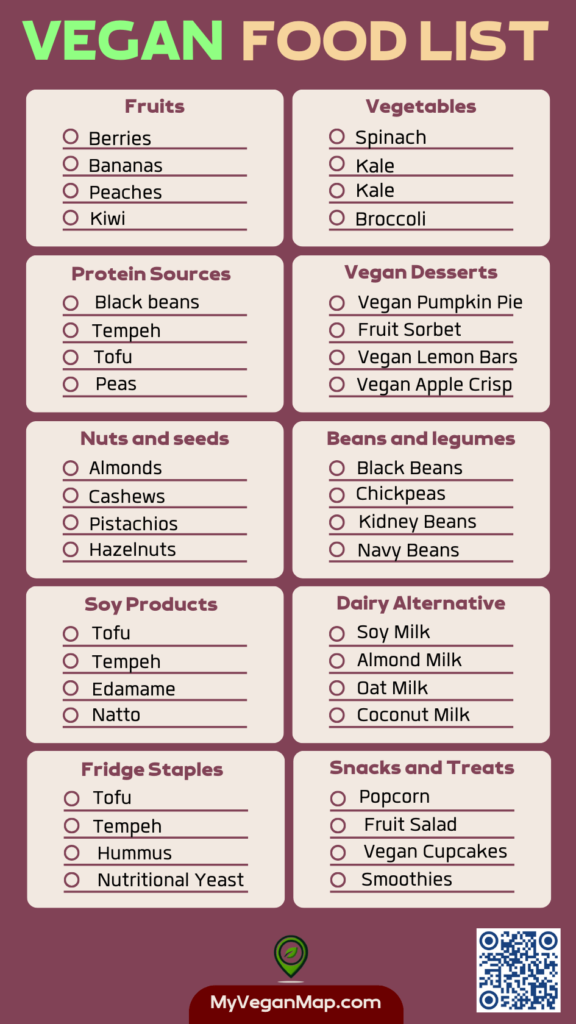
So let’s know the detailed Vegan Foods List for Beginners.
1) Fruits List: Fresh, Frozen, and Dried
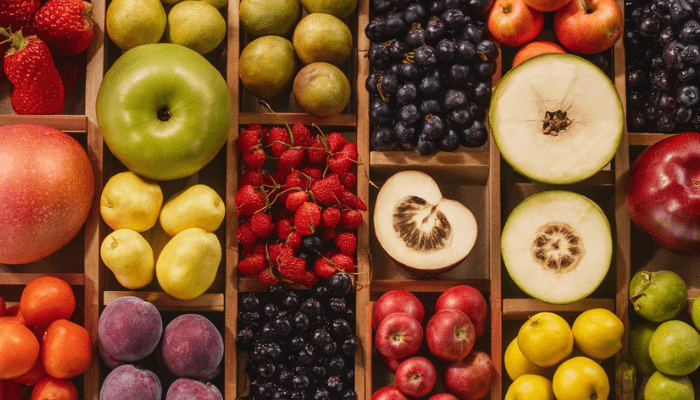
1) Fresh Fruits:
- Berries: Vitamin C, antioxidants, fiber (Strawberries, Blueberries, Raspberries, Blackberries, Cranberries, Goji Berries, Acai Berries)
- Citrus Fruits: Vitamin C, antioxidants, fiber (Oranges, Lemons, Limes, Grapefruits, Tangerines)
- Tropical Fruits: Vitamins A, C, fiber, antioxidants (Mangoes, Pineapples, Papayas, Bananas, Coconuts, Passion Fruit, Guava, Lychee)
- Stone Fruits: Vitamins A, C, antioxidants, fiber (Peaches, Plums, Cherries, Apricots, Nectarines)
- Other Fresh Fruits: Vitamin C, fiber, antioxidants (Apples, Pears, Grapes, Kiwi, Pomegranates, Melons, Figs, Persimmons, Dragon Fruit)
2) Frozen Fruits:
- Berries: Retain Vitamin C, antioxidants, fiber (Strawberries, Blueberries, Raspberries, Blackberries, Mixed Berries)
- Tropical Fruits: Retain Vitamins A, C, fiber, antioxidants (Mangoes, Pineapples, Papayas, Bananas, Coconut Chunks, Passion Fruit Pulp)
- Stone Fruits: Retain Vitamins A, C, antioxidants, fiber (Peaches, Plums, Cherries, Apricots)
- Other Frozen Fruits: Retain Vitamin C, fiber, antioxidants (Apples, Pears, Grapes, Kiwi, Melon Balls, Dragon Fruit)
3) Dried Fruits:
- Common Dried Fruits: Nutrient-dense with vitamins, minerals, and fiber (Raisins, Dried Apricots, Dried Figs, Dates, Prunes, Dried Apples, Dried Pears, Dried Persimmons)
- Dried Berries: Concentrated antioxidants and fiber (Dried Cranberries, Blueberries, Strawberries, Raspberries, Goji Berries, Acai Berries)
- Dried Tropical Fruits: Vitamins, minerals, and fiber (Dried Mangoes, Pineapples, Papayas, Bananas, Coconuts)
- Dried Stone Fruits: Packed with vitamins, minerals, and fiber (Dried Peaches, Plums, Cherries, Apricots)
2) Vegetables: Fresh, Frozen and Canned
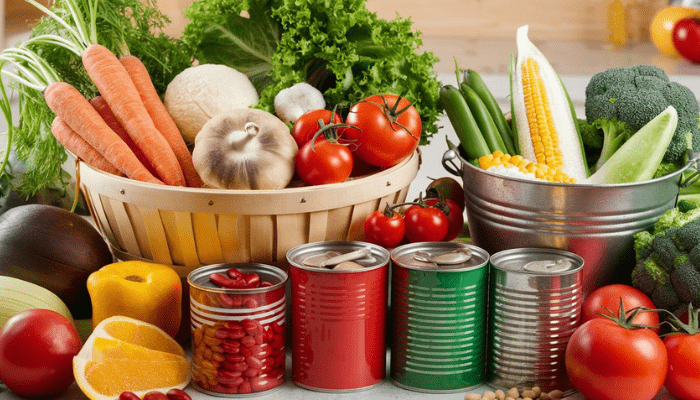
1) Fresh
Fresh vegetables are the cornerstone of a vibrant vegan diet. They are packed with nutrients, fiber, and natural flavors. Here’s a detailed list of fresh vegetables to include in your vegan food list:
Leafy Greens:
- Spinach: Packed with iron, calcium, vitamins A, C, and K. Low-calorie and loaded with antioxidants.
- Kale: Rich in vitamins A, K, and C, plus calcium and antioxidants.
- Swiss Chard: Provides vitamins A, K, and C, along with magnesium and iron for strong bones.
- Arugula: Contains vitamins A, K, and C, calcium, and folate, with a peppery kick.
- Romaine Lettuce: Good source of vitamins A and K, folate, and fiber, with few calories.
Cruciferous Vegetables:
- Broccoli: High in vitamins C and K, fiber, and potassium, supporting immune function.
- Cauliflower: Offers vitamins C and K, folate, and fiber, low in calories.
- Brussels Sprouts: Rich in vitamins C and K, fiber, and antioxidants, great for digestion.
- Cabbage: High in vitamins C and K, folate, and fiber, promoting heart health.
- Bok Choy: Contains vitamins A, C, and K, plus calcium and potassium for bones.
Root Vegetables:
- Carrots: Packed with beta-carotene, fiber, and vitamins A, K, and C, great for eyesight.
- Beets: Rich in folate, manganese, fiber, and antioxidants, helping regulate blood pressure.
- Radishes: Provides vitamin C, potassium, and fiber, hydrating and low-calorie.
- Turnips: Offers vitamin C, fiber, and potassium, aiding digestion.
- Sweet Potatoes: High in beta-carotene, vitamins A and C, fiber, and potassium, boosts immunity.
Alliums:
- Onions: High in vitamin C, fiber, and antioxidants, known for anti-inflammatory properties.
- Garlic: Rich in manganese, vitamin B6, vitamin C, and selenium, supports heart health.
- Leeks: Packed with vitamins A, C, and K, folate, and fiber, beneficial for cardiovascular health.
- Shallots: Provides vitamins A and C, folate, and antioxidants, supporting the immune system.
- Scallions: Contains vitamins A and C, calcium, and fiber, good for bone health.
Nightshades:
- Tomatoes: High in vitamin C, potassium, folate, and lycopene, promoting heart health.
- Eggplants: Fiber-rich, with vitamins B1 and B6, and antioxidants for brain health.
- Bell Peppers: Rich in vitamins A, C, and B6, folate, and fiber, supporting immunity.
- Chili Peppers: Packed with vitamin C, capsaicin, and antioxidants, anti-inflammatory properties.
- Potatoes: Contains vitamin C, potassium, and fiber, providing energy and aiding digestion.
Squashes and Gourds:
- Zucchini: Low in calories, high in vitamin C, potassium, and fiber, great for hydration.
- Yellow Squash: Provides vitamins A and C, fiber, and manganese, supporting eye health.
- Butternut Squash: Rich in vitamins A and C, fiber, and potassium, boosts immune function.
- Pumpkin: High in beta-carotene, vitamins A and C, fiber, and potassium, supports vision health.
- Acorn Squash: Contains vitamins A and C, fiber, and potassium, aiding digestion.
Legumes (Fresh):
- Green Beans: High in vitamins A, C, and K, folate, and fiber, promoting bone health.
- Snow Peas: Contains vitamins A, C, and K, fiber, and folate, aiding digestion.
- Sugar Snap Peas: Provides vitamins A, C, and K, fiber, and folate, boosting immune function.
- Fresh Peas: Rich in vitamins A, C, and K, fiber, and protein, supporting muscle health.
- Edamame: High in protein, fiber, vitamins K and C, and folate, supports heart health.
Other Fresh Vegetables:
- Cucumbers: Low in calories, high in water content, vitamins K and C, excellent for hydration.
- Celery: Provides vitamins A, K, and C, folate, and fiber, supports digestive health.
- Mushrooms: Rich in B vitamins, selenium, and antioxidants, boosting immune function.
- Corn: High in fiber, vitamins B and C, and antioxidants, aids digestion.
- Asparagus: Contains vitamins A, C, and K, folate, and fiber, beneficial for digestion.
2) Frozen Vegetables
Frozen vegetables are a great alternative when fresh produce is not available or when you need to save time on meal prep. They retain most of their nutrients and can be a convenient option for quick meals. Here’s a list of common frozen vegetables and their nutritional benefits:
Leafy Greens:
- Spinach: High in vitamins A, C, and K, folate, and iron. Supports bone health.
- Kale: Rich in vitamins A, K, and C, calcium, and antioxidants. Good for detox.
- Collard Greens: Packed with vitamins A, K, and C, calcium, and fiber. Supports bones.
Mixed Vegetables:
- Peas, Carrots, Corn, and Green Beans Mix: Vitamins A, C, and K, fiber, and antioxidants. Overall health.
- Stir-fry Vegetable Mix: Diverse veggies with vitamins A and C, fiber, and antioxidants. Boosts immunity.
- Mediterranean Vegetable Mix: Includes vitamins A, C, and K, fiber, and antioxidants. Heart health.
Single Vegetables:
- Broccoli Florets: Vitamins C and K, fiber, and potassium. Supports immunity.
- Cauliflower Florets: Vitamins C and K, fiber, and folate. Low calorie.
- Green Beans: Vitamins A, C, and K, folate, and fiber. Supports bones.
- Peas: Vitamins A, C, and K, fiber, and protein. Good for muscles.
- Corn Kernels: High fiber, vitamins B and C, antioxidants. Digestive health.
Specialty Frozen Vegetables:
- Edamame: Protein, fiber, vitamins K and C, folate. Heart health.
- Artichoke Hearts: Fiber, vitamin C, antioxidants. Liver health.
- Brussels Sprouts: Vitamins C and K, fiber, antioxidants. Digestive health.
- Butternut Squash Cubes: Vitamins A and C, fiber, potassium. Immune support.
3) Canned Vegetables
Canned vegetables are convenient for long-term storage and can be as nutritious as fresh or frozen ones if chosen without added salt or preservatives. Here are some popular options and their benefits:
1) Tomatoes:
- Diced Tomatoes: Rich in vitamin C, potassium, folate, and lycopene, supporting heart health.
- Crushed Tomatoes: Packed with vitamins C and K, potassium, and antioxidants, boosting immunity.
- Tomato Paste: High in vitamins A and C, potassium, and antioxidants, promoting heart health.
- Tomato Sauce: Provides vitamins C and K, potassium, and antioxidants, supporting immune health.
2) Legumes:
- Chickpeas: High in protein, fiber, vitamins B6 and C, and folate, aiding digestion.
- Black Beans: Rich in protein, fiber, vitamins B6 and C, and folate, beneficial for muscles.
- Kidney Beans: Contains protein, fiber, vitamins B6 and C, and folate, supporting heart health.
- Lentils: High in protein, fiber, iron, and folate, enhancing energy and muscle health.
- Green Beans: Provides vitamins A, C, and K, folate, and fiber, promoting bone health.
3) Corn and Peas:
- Sweet Corn: High fiber, vitamins B and C, and antioxidants, good for digestion.
- Creamed Corn: Contains fiber, vitamins B and C, and antioxidants, supporting digestive health.
- Green Peas: Rich in vitamins A, C, and K, fiber, and protein, beneficial for muscles.
4) Other Canned Vegetables:
- Artichoke Hearts: High fiber, vitamin C, and antioxidants, promoting liver health.
- Hearts of Palm: Contains fiber, vitamins B6 and C, and folate, supporting heart health.
- Mushrooms: Provides B vitamins, selenium, and antioxidants, boosting immune function.
- Asparagus: Rich in vitamins A, C, and K, folate, and fiber, aiding digestion.
- Beets: High in folate, manganese, fiber, and antioxidants, helping regulate blood pressure.
Tips for Choosing the Best Vegetables:
1) Fresh Vegetables: opt for vibrant colors, firm textures, and no signs of wilting.
2) Frozen Vegetables: Choose packages without ice crystals or signs of thawing for better quality.
3) Canned Vegetables: Select low-sodium or no-salt-added versions and check for no added sugars or preservatives.
Fact: Up to 91% of Amazon rainforest destruction is caused by animal agriculture.
3) Nuts and seeds
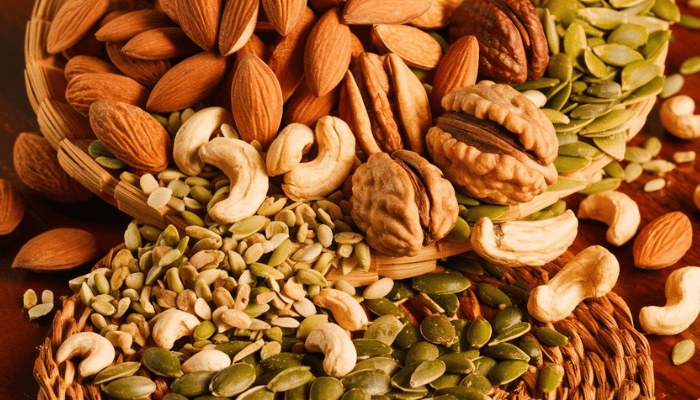
Nuts and seeds are crucial in a vegan diet, packed with protein, healthy fats, vitamins, and minerals. Here’s a quick guide to popular options, their benefits, and tips for adding them to your meals.
- Almonds: Rich in vitamin E, magnesium, fiber, protein, and antioxidants. Enjoy raw, as butter, in salads, or smoothies.
- Walnuts: Packed with omega-3s, antioxidants, protein, and fiber. Great for baking, oatmeal, or salads.
- Cashews: Creamy texture with monounsaturated fats, copper, magnesium, and protein. Snack on raw or roasted, use in vegan dishes.
- Pecans: Good source of healthy fats, fiber, vitamins, and minerals. Perfect in pies, salads, or as a snack.
- Hazelnuts: High in healthy fats, fiber, vitamins, and minerals like vitamin E and copper. Use in desserts, spreads, or savory dishes.
- Pistachios: High in protein, fiber, antioxidants, and healthy fats. Enjoy as a snack, in salads, or baking.
- Chia Seeds: Omega-3s, fiber, protein. Blend in smoothies, make chia pudding, or use in baking.
- Flaxseeds: Omega-3s, fiber, lignans. Ground for smoothies, oatmeal, or baking.
- Pumpkin Seeds: Protein, magnesium, iron, zinc, antioxidants. Roast for a snack, add to granola, or salads.
- Sunflower Seeds: Vitamin E, selenium, healthy fats, protein, fiber. Eat raw or roasted, in salads, or spreads.
- Hemp Seeds: Complete protein, omega fatty acids, vitamins, minerals. Sprinkle on salads, blend in smoothies, or bake.
- Sesame Seeds: Healthy fats, protein, minerals. Use in baking, salads, or as tahini.
- Incorporating Nuts & Seeds: Blend in smoothies, top salads, use in baking, snacks, or spreads.
4) Beans and legumes
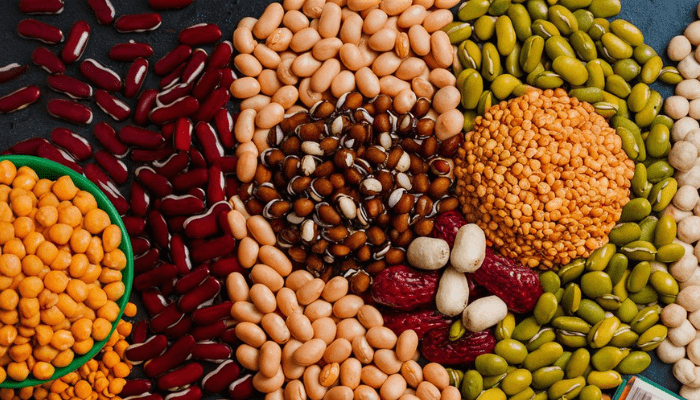
Beans and legumes are key to a balanced vegan diet. They’re rich in protein, fiber, vitamins, and minerals.
1) Black Beans
- Benefits: High protein, fiber, iron, magnesium, folate.
- Uses: Soups, burritos, salads, stews.
2) Chickpeas (Garbanzo Beans)
- Benefits: Protein, fiber, folate, iron, phosphorus.
- Uses: Hummus, falafel, salads, curries.
3) Lentils
- Benefits: Protein, fiber, iron, folate, antioxidants.
- Uses: Soups, stews, salads, curries.
4) Kidney Beans
- Benefits: Protein, fiber, iron, potassium.
- Uses: Chili, soups, stews; slow-cooking.
5) Pinto Beans
- Benefits: Protein, fiber, folate, iron, magnesium.
- Uses: Refried beans, burritos, soups.
6) Navy Beans
- Benefits: Protein, fiber, folate, magnesium.
- Uses: Baked beans, soups, stews.
7) Cannellini Beans
- Benefits: Protein, fiber, iron, magnesium.
- Uses: Minestrone, salads.
8) Adzuki Beans
- Benefits: Protein, fiber, iron, folate, antioxidants.
- Uses: East Asian dishes, and desserts.
9) Soybeans
- Benefits: Protein, fiber, iron, calcium, magnesium.
- Uses: Tofu, tempeh, soy milk, edamame.
10) Lima Beans
- Benefits: Protein, fiber, folate, iron.
- Uses: Succotash, soups, stews.
11) Mung Beans
- Benefits: Protein, fiber, folate, iron, antioxidants.
- Uses: Soups, salads, stir-fries.
12) Black-Eyed Peas
- Benefits: Protein, fiber, folate, iron.
- Uses: Southern cuisine, soups, stews.
5) Soy Products

Soy products are versatile and nutritious for vegans. They’re rich in plant-based protein, essential vitamins, and minerals, making them a great addition to any diet.
- Tofu: Protein-packed soy blocks with iron, calcium, and more.
- Tempeh: Fermented soybeans, loaded with protein, probiotics, and vitamins.
- Soy Milk: Plant-based milk with protein, calcium (if fortified), and vitamins.
- Edamame: Young soybeans, high in protein and fiber.
- Miso: Fermented soybean paste, rich in probiotics and vitamins.
- Soy Yogurt: Dairy-free yogurt with protein and probiotics.
- Soy Sauce: Salty condiment, low in calories but high in sodium.
- Natto: Fermented soybeans, high in protein and probiotics.
- Soy Protein Isolate: Pure protein from soy, low in fat and carbs.
- TVP: Dehydrated soy, great meat substitute, high in protein.
- Soy Nuts: Roasted soybeans, packed with protein and fiber.
6) Fridge Staples
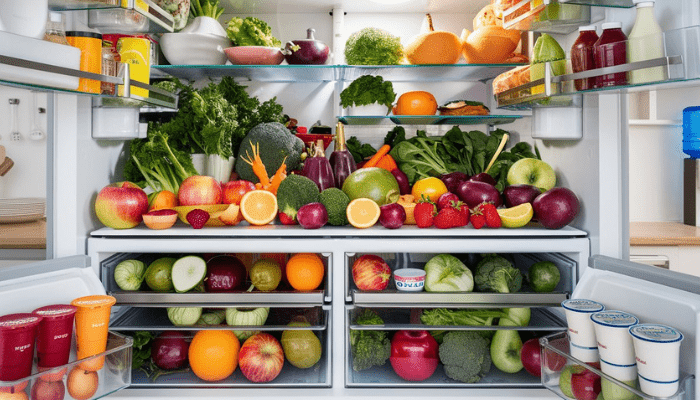
1) Leafy Greens (Spinach, Kale)
- Nutrients: Rich in vitamins A, C, and K, folate, iron.
- Use: Salads, smoothies, stir-fries.
2) Tofu
- Nutrients: High in protein, iron, calcium, magnesium.
- Use: Grilled, stir-fried, baked, blended.
3) Tempeh
- Nutrients: High in protein, fiber, vitamins, minerals.
- Use: Marinated, grilled, sautéed.
4) Non-Dairy Milk (Almond, Soy, Oat)
- Nutrients: Fortified with calcium, vitamin D, B12.
- Use: Cereal, baking, smoothies, coffee creamer.
5) Fresh Fruits (Berries, Apples, Citrus)
- Nutrients: High in vitamins, antioxidants, fiber.
- Use: Raw, in salads, smoothies.
6) Vegetables (Bell Peppers, Carrots, Broccoli)
- Nutrients: Provide vitamins, minerals, fiber.
- Use: Raw, steamed, roasted, sautéed.
7) Hummus
- Nutrients: Contains protein, fiber, healthy fats.
- Use: Dip, spread, salad topping.
8) Nutritional Yeast
- Nutrients: Rich in B vitamins, B12 (if fortified).
- Use: Adds cheesy flavor to dishes, sauces, popcorn.
9) Chia Seeds
- Nutrients: High in omega-3s, fiber, protein.
- Use: Smoothies, oatmeal, egg substitute.
10) Flaxseed
- Nutrients: Source of omega-3s, fiber, antioxidants.
- Use: Smoothies, baked goods, egg substitute.
11) Beans (Black Beans, Chickpeas)
- Nutrients: High in protein, fiber, iron, folate.
- Use: Salads, soups, stews, spreads.
12) Quinoa
- Nutrients: Complete protein, rich in fiber, iron, magnesium.
- Use: Salads, stir-fries, side dish.
13) Whole Grain Bread (Sprouted Grain, Whole Wheat)
- Nutrients: Provides fiber, B vitamins, minerals.
- Use: Toasted, sandwiches.
14) Avocados
- Nutrients: Rich in healthy fats, vitamins C, E, K, B vitamins.
- Use: Toast, guacamole, salads, wraps.
15) Sauerkraut and Kimchi
- Nutrients: Probiotic-rich, aids gut health, digestion.
- Use: Sandwiches, salads, side dish.
16) Coconut Milk/Yogurt
- Nutrients: Contains healthy fats, some vitamins and minerals.
- Use: Dairy substitute in curries, smoothies, desserts.
17) Seitan (Wheat Gluten)
- Nutrients: High in protein, iron.
- Use: Sautéed, grilled, baked.
18) Miso Paste
- Nutrients: Source of probiotics, vitamins, minerals.
- Use: Soups, dressings, marinades.
19) Frozen Vegetables (Peas, Corn, Mixed)
- Nutrients: Retain vitamins, minerals; convenient.
- Use: Steamed, stir-fries, soups, casseroles.
20) Nut Butters (Peanut Butter, Almond Butter)
- Nutrients: High in protein, healthy fats.
- Use: Spread, smoothies, baking.
7) Dairy Alternative
There is a wide variety of plant-based dairy alternatives that are both delicious and eco-friendly, making them ideal for your vegan food list.
1. Plant-Based Milk
Soy Milk:
- Ingredients: Soybeans and water.
- Nutrition: Rich in protein, often fortified with calcium, vitamin D, and B12.
- Usage: Suitable for drinking, cooking, baking, and frothing for coffee.
Almond Milk:
- Ingredients: Ground almonds and water.
- Nutrition: Low in calories, contains healthy fats, often fortified with calcium and vitamin E.
- Usage: Great for drinking, cereal, smoothies, and baking; not ideal for frothing.
Oat Milk:
- Ingredients: Oats blended with water.
- Nutrition: Creamy, naturally sweet, often fortified with calcium and vitamin D.
- Usage: Excellent for coffee, baking, and sauces; ensure gluten-free for those with intolerance.
Coconut Milk:
- Ingredients: Grated coconut flesh and water.
- Nutrition: Rich, creamy, high in saturated fats.
- Usage: Versatile for curries, desserts, soups, and cocktails; available in light to full-fat.
Rice Milk:
- Ingredients: Milled rice blended with water.
- Nutrition: Hypoallergenic, naturally sweet, low in protein; often fortified with calcium and vitamins.
- Usage: Suitable for drinking, cereal, and cooking; lighter consistency.
2) Plant-Based Yogurt
Soy Yogurt:
- Ingredients: Soy milk and live cultures.
- Nutrition: Creamy, high in protein, often fortified with calcium and vitamin D.
- Usage: Enjoy plain, with granola, in smoothies, and as a yogurt substitute.
Almond Yogurt:
- Ingredients: Almond milk and live cultures.
- Nutrition: Nutty flavor, smooth, lower in protein.
- Usage: Similar to soy yogurt; good for those allergic to soy.
Coconut Yogurt:
- Ingredients: Coconut milk and live cultures.
- Nutrition: Creamy, mild coconut taste, rich in healthy fats.
- Usage: Ideal for tropical flavors, desserts, and curries; often fruit-infused.
3) Plant-Based Cheese
Nut Cheese:
- Ingredients: Cashews, almonds, or other nuts blended with probiotics.
- Varieties: Soft, aged, and flavored (e.g., smoked, herb-infused).
- Usage: Great for crackers, sandwiches, pasta, and cheese boards; some melt well.
Soy Cheese:
- Ingredients: Soy milk with added oils and thickeners.
- Varieties: Shredded, sliced, blocks; melts well, flavors like mozzarella and cheddar.
- Usage: Perfect for pizzas, grilled cheese, and casseroles.
Coconut Oil-Based Cheese:
- Ingredients: Refined coconut oil with starches and flavorings.
- Varieties: Soft spreads, firm blocks; texture and meltability vary.
- Usage: Good for spreading on bread, crackers, and melting in recipes.
4) Plant-Based Butter
Coconut Oil Butter:
- Ingredients: Refined coconut oil with emulsifiers and flavorings.
- Nutrition: High in saturated fats, similar texture to dairy butter.
- Usage: Spreads on bread, melts for cooking and baking, suitable for frying.
Avocado Butter:
- Ingredients: Avocado blended with coconut or olive oil.
- Nutrition: Rich in healthy fats, vitamins, and minerals.
- Usage: Spread on toast, dip for veggies, or melt for sautéing.
5) Plant-Based Cream
Coconut Cream:
- Ingredients: Thick part of coconut milk or concentrated coconut milk.
- Nutrition: Rich, creamy, high in saturated fats.
- Usage: Ideal for desserts, curries, sauces, and soups; varies in fat content.
Soy Cream:
- Ingredients: Soy milk with added thickeners.
- Nutrition: Creamy texture, versatile for savory and sweet dishes.
- Usage: Use in cooking, baking, and as a base for sauces and soups; various fat contents available.
6) Other Dairy Alternatives
Nutritional Yeast:
- Ingredients: Deactivated yeast, often fortified with B vitamins.
- Usage: Adds cheesy flavor to sauces, soups, popcorn, and pasta.
Aquafaba:
- Ingredients: Liquid from canned chickpeas.
- Usage: Whip into meringues, egg replacer in baking, adds texture to desserts.
These dairy alternatives cater not only to vegans but also to individuals with lactose intolerance or other dietary preferences.
8) Protein Sources
a) Legumes:
- Lentils: Protein and fiber-rich; great for soups, stews, salads.
- Chickpeas: Perfect for curries, salads, snacks.
- Black beans: High in protein; ideal for tacos, salads, soups.
- Kidney beans: Protein-packed; used in chili, salads, burgers.
- Peas: Protein source; used in soups, stews, sides.
b) Tofu and Tempeh:
- Tofu: Versatile soy product; great in stir-fries, scrambles, desserts.
- Tempeh: Protein-dense; excellent in sandwiches, stir-fries.
c) Whole Grains:
- Quinoa: Complete protein; used in salads, pilafs, sides.
- Brown rice: More protein than white rice; versatile in dishes.
- Oats: Protein-rich; for breakfast, baking, granola.
d) Nuts and Seeds:
- Almonds: High in protein; snacks, salads, almond butter.
- Chia seeds: Protein-rich; smoothies, puddings, baking.
- Pumpkin seeds: Protein source; added to salads, granola, soups.
- Hemp seeds: Complete protein; in smoothies, salads, baking.
e) Soy Products:
- Edamame: High-protein snack or salad addition.
- Soy milk: Protein-fortified dairy alternative.
f) Vegetables:
- Spinach: Protein source; in salads, smoothies, sautés.
- Broccoli: Protein-rich; used in stir-fries, salads, sides.
g) Protein Powders:
- Pea protein: From yellow peas; in smoothies, protein bars.
- Brown rice protein: From whole grain rice; in shakes, snacks.
9) Whole Grains
Here’s a detailed list of some common whole grains that are suitable for a vegan diet:
- Quinoa: Complete protein, super versatile.
- Brown Rice: Fiber-rich, full of minerals.
- Oats: Great for heart health, breakfast champ.
- Barley: Nutty, chewy, packed with fiber.
- Buckwheat: Gluten-free, protein-rich.
- Whole Wheat: More fiber, more nutrients.
- Millet: Gluten-free, great for porridges.
- Farro: Ancient grain, nutty, protein-rich.
- Amaranth: Gluten-free, lots of protein and calcium.
- Triticale: Wheat-rye mix, fiber-packed.
- Wild Rice: Nutty, aromatic, protein-rich.
- Sorghum: Gluten-free, antioxidant-rich.
- Spelt: Easier to digest, perfect for baking.
- Teff: Tiny, gluten-free, iron and calcium boost.
- Freekeh: Smoky flavor, protein-rich.
- Rye: Hearty and dense, fiber-rich.
- Bulgur: Quick-cooking, super versatile.
- Brown Teff: Nutty flavor, gluten-free.
- Emmer: Chewy, nutty, ancient grain.
- Kamut: Buttery flavor, high in protein.
10) Cooking Oils
Here’s a detailed list of some popular vegan cooking oils from around the world:
- Olive Oil: Healthy, versatile; used for salads and low-heat cooking.
- Coconut Oil: Solid, great for baking, frying, and sautéing; adds coconut flavor.
- Avocado Oil: High smoke point, buttery taste; perfect for high-heat cooking.
- Sesame Oil: Nutty flavor, best for Asian dishes; use sparingly.
- Sunflower Oil: Neutral taste, high smoke point; good for frying and baking.
- Peanut Oil: Nutty flavor, high smoke point; ideal for frying and deep-frying.
- Canola Oil: Neutral flavor, high smoke point; versatile for cooking.
- Grapeseed Oil: Neutral taste, high smoke point; good for frying and dressings.
- Flaxseed Oil: Nutty flavor, high omega-3s; use in dressings and dips.
- Rice Bran Oil: Mild flavor, high smoke point; perfect for Asian cooking.
11) Herbs & Spices
Herbs:
- Basil: Fresh, sweet; ideal for Italian and Mediterranean dishes.
- Cilantro (Coriander): Citrusy, herbal; popular in Latin American, Indian, and Southeast Asian cuisines.
- Parsley: Bright, slightly peppery; enhances a variety of dishes.
- Thyme: Earthy, floral; great for stews, soups, and roasted veggies.
- Rosemary: Strong, aromatic; perfect for roasted potatoes and bread.
- Oregano: Robust, slightly bitter; common in Italian and Mediterranean dishes.
- Mint: Refreshing, cooling; used in Middle Eastern, South Asian cuisines, salads, and teas.
- Chives: Mild onion-like; excellent for garnishing.
Spices:
- Cumin: Earthy, warm; essential in curries, chili, and Mexican dishes.
- Turmeric: Vibrant yellow, slightly bitter; used in curries and rice dishes.
- Paprika: Mild, sweet, smoky; adds flavor to stews, soups, and as a garnish.
- Chili Powder: Spicy, adds depth; perfect for Mexican and Tex-Mex dishes.
- Ginger: Warm, spicy; versatile in sweet and savory Asian dishes.
- Cinnamon: Sweet, warming; great for desserts, oatmeal, and spiced drinks.
- Cardamom: Aromatic, citrusy; used in Indian and Middle Eastern desserts, beverages.
- Coriander Seed: Warm, citrusy; ground into curries or pickling blends.
These herbs and spices not only enhance vegan dishes but also provide antioxidants, vitamins, and minerals to your diet.
12) Sauces & sweeteners
Vegan Sauces:
- Tomato Sauce: Versatile base for pasta and pizzas.
- Pesto: Made with basil, pine nuts, and olive oil.
- Hummus: Creamy dip with chickpeas, tahini, lemon, and garlic.
- Guacamole: Avocado, lime juice, tomatoes, onions, and cilantro.
- Salsa: Tomato-based with onions, peppers, and spices.
- Barbecue Sauce: Look for vegan versions without honey or animal products.
- Thai Peanut Sauce: Peanut butter, coconut milk, soy sauce, and spices.
- Tahini Sauce: Sesame seeds, lemon juice, garlic, and water.
- Chimichurri: Argentinean sauce with parsley, garlic, vinegar, and olive oil.
- Teriyaki Sauce: Soy sauce, sugar, ginger, and garlic (check for vegan options).
Vegan Sweeteners:
- Maple Syrup: From maple tree sap, for pancakes and desserts.
- Agave Nectar: Sweet syrup from the agave plant, in baking and drinks.
- Coconut Sugar: Caramel-like sweetness from coconut palm blossoms.
- Date Syrup: Rich sweetness with a hint of caramel from dates.
- Stevia: Natural sweetener from the Stevia plant, in liquid or powder.
- Molasses: Rich, dark byproduct for baking and marinades.
- Brown Rice Syrup: Mild sweetness made from cooked brown rice.
- Fruit Purees: Natural sweetening with mashed bananas or applesauce.
- Monk Fruit Sweetener: Zero-calorie sweetener from monk fruit.
- Sorghum Syrup: Sweet, tangy syrup from sorghum plants.
13) Vegan Desserts
- Vegan Chocolate Avocado Mousse: Creamy, rich dessert with ripe avocados and dairy-free chocolate.
- Vegan Pumpkin Pie: Seasonal favorite with spiced pumpkin filling and dairy-free crust.
- Coconut Milk Rice Pudding: Creamy rice pudding made with coconut milk.
- Vegan Banana Bread: Moist and flavorful, made without eggs or dairy.
- Vegan Chocolate Chip Cookies: Classic cookies with dairy-free chocolate and plant-based butter.
- Fruit Sorbet: Refreshing, fruity treat sweetened with natural sugars.
- Vegan Lemon Bars: Tangy, sweet bars with a vegan shortbread crust and lemon curd filling.
- Vegan Apple Crisp: Warm and comforting, topped with crumbly oat topping without butter.
- Chia Seed Pudding: Healthy, creamy pudding with chia seeds and coconut milk, topped with fresh fruits.
- Vegan Chocolate Cake: Rich, decadent cake without eggs or dairy, frosted with vegan chocolate ganache.
Perfect for vegans and those seeking healthier, plant-based sweet options.
14) Snacks and Treats
Savory Snacks:
- Roasted Chickpeas: Crunchy and protein-packed, seasoned with spices.
- Popcorn: Air-popped with nutritional yeast or spices for flavor.
- Guacamole with Veggie Sticks: Fresh guacamole paired with carrot, celery, and cucumber sticks.
- Sweet Potato Fries: Baked and seasoned with herbs and spices.
- Hummus and Pita Chips: Classic hummus served with whole wheat or gluten-free pita chips.
Sweet Treats
- Fruit Salad: Refreshing mix of seasonal fruits.
- Dark Chocolate: Vegan dark chocolate bars with high cocoa content.
- Energy Balls: Dates, nuts, and seeds rolled in coconut or cocoa powder.
- Vegan Cookies: Oatmeal raisin, peanut butter, or chocolate chip, dairy and egg-free.
- Chia Seed Pudding: Chia seeds soaked in almond milk with vanilla and sweetened.
Baked Goods:
- Vegan Cupcakes: Vanilla, chocolate, or lemon flavors with dairy-free frosting.
- Banana Bread: Moist and delicious, made with ripe bananas and non-dairy milk.
- Vegan Brownies: Rich and fudgy, made with vegan chocolate and flaxseed meal.
- Apple Cinnamon Muffins: Whole grain with applesauce and cinnamon.
- Pumpkin Spice Loaf: Seasonal favorite with pumpkin puree and spices.
Drinks:
- Smoothies: Blend fruits, greens, and almond milk for a nutritious snack.
- Iced Herbal Teas: Refreshing options like mint, chamomile, or hibiscus.
- Almond Milk Hot Chocolate: Warm almond milk with cocoa and sweetener.
- Fruit Infused Water: Cold water with citrus slices, berries, or cucumber.
These snacks and treats appeal to vegans and those exploring plant-based options, offering variety and nutritional benefits.
15) Vegan Beverages
- Almond Milk
- Soy Milk
- Coconut Milk
- Oat Milk
- Rice Milk
- Cashew Milk
- Hemp Milk
- Flax Milk
- Hazelnut Milk
- Pea Milk
- Fruit Smoothies
- Vegetable Juices
- Herbal Teas
- Coffee (black)
- Green Tea
- Matcha Latte
- Golden Milk (Turmeric Latte)
- Kombucha
- Sparkling Water
- Fruit Infused Water
16) Vegan Powder
Why Vegan Protein Powder?
- Allergen-Friendly: Often free from dairy, soy, and gluten.
- Digestive Health: Easier on the digestive system, for those with lactose intolerance.
- Nutrient-rich: Packed with vitamins, minerals, and antioxidants.
- Sustainability: Lower environmental impact than animal proteins.
Top Vegan Protein Powders
Pea Protein:
- Source: Yellow split peas.
- Benefits: High in BCAAs for muscle growth, hypoallergenic.
- Taste: Mild, blends well in smoothies.
Brown Rice Protein:
- Source: Whole-grain brown rice.
- Benefits: Rich in essential amino acids, easy to digest.
- Taste: Slightly sweet, best mixed with other ingredients.
Hemp Protein:
- Source: Hemp seeds.
- Benefits: Contains omega-3 and omega-6, fiber, and all nine essential amino acids.
- Taste: Nutty, great in shakes and baking.
Soy Protein:
- Source: Dehulled and defatted soybeans.
- Benefits: Complete protein, high in BCAAs for muscle recovery.
- Taste: Neutral, blends well with various flavors.
Pumpkin Seed Protein:
- Source: Pumpkin seeds.
- Benefits: High in magnesium, zinc, and iron.
- Taste: Nutty, perfect for smoothies or baking.
Sunflower Seed Protein:
- Source: Sunflower seeds.
- Benefits: Rich in BCAAs and essential fatty acids.
- Taste: Mild and slightly nutty, versatile.
Quinoa Protein:
- Source: Quinoa.
- Benefits: Complete protein, high in fiber and essential amino acids.
- Taste: Mild, blends well with other flavors.
Choosing the Right One
- Protein Content: Aim for 15-25 grams per serving.
- Amino Acid Profile: Look for a complete profile or mix types.
- Additives: Minimal ingredients, avoid added sugars and preservatives.
- Digestibility: Try different types to see what suits you.
- Taste and Texture: Pick one you enjoy, as you’ll consume it regularly.
FAQ
Q: What does it mean to be vegan?
Ans: Being vegan involves eliminating all animal products from one’s diet and lifestyle, including meat, dairy, eggs, and any other animal-derived substances.
Q: How can I get enough protein on a vegan diet?
Ans: Protein can be sourced from beans, lentils, tofu, tempeh, nuts, seeds, quinoa, and plant-based protein powders.
Q: Are there vegan options when dining out?
Ans: Most restaurants offer vegan-friendly dishes such as salads, veggie burgers, pasta with marinara sauce, vegetable stir-fries, and meals made with tofu or tempeh.
Disclaimer: I am not a health professional. The information provided on this blog is based on personal research and experience and is intended for informational purposes only. It should not be considered as medical advice. Please consult with a healthcare professional before making any dietary changes or decisions.

